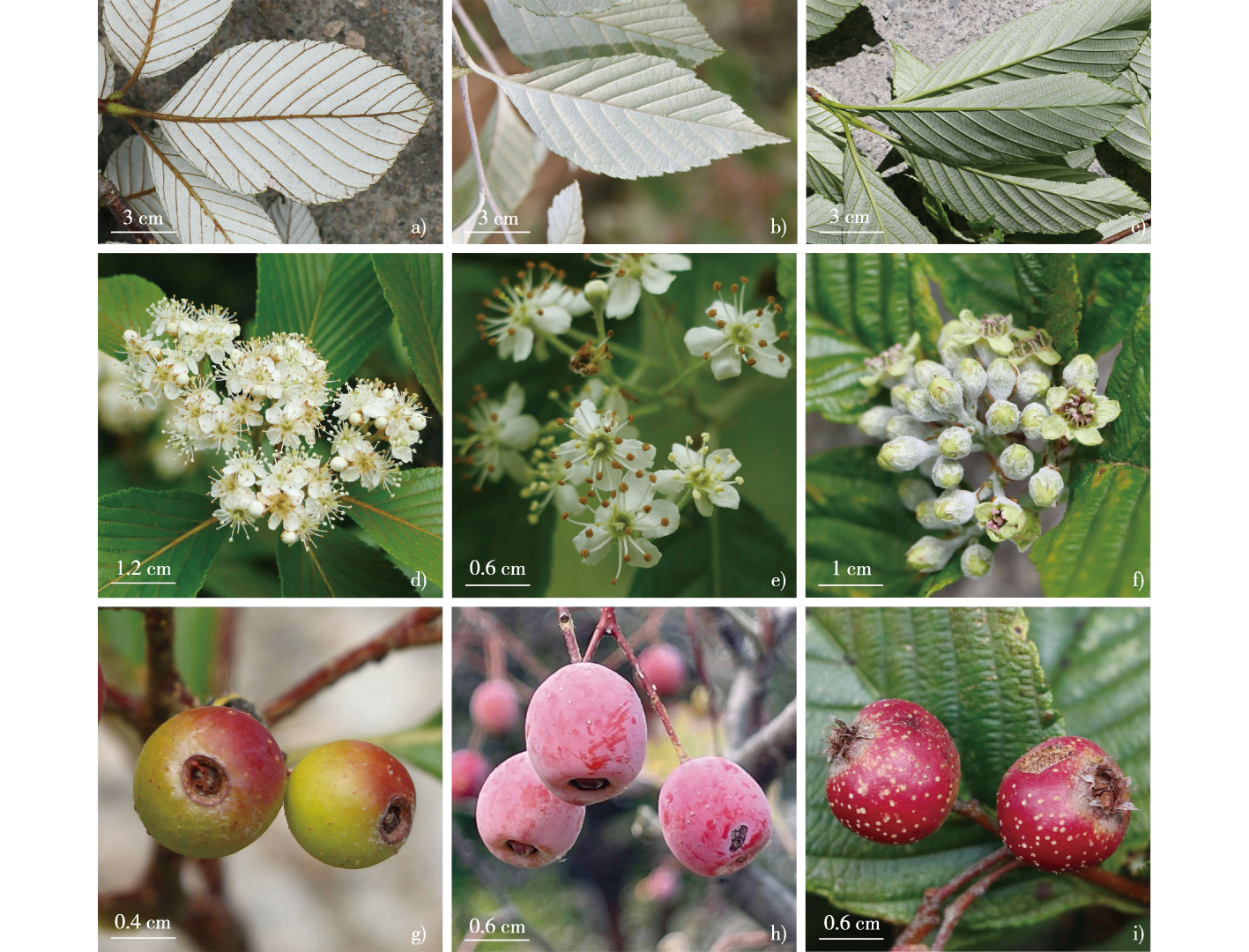 PDF(11845 KB)
PDF(11845 KB)


 PDF(11845 KB)
PDF(11845 KB)
 PDF(11845 KB)
PDF(11845 KB)
蔷薇科花楸属白毛系的系统发生分析
Phylogenetic analysis of Sorbus ser. Folgnerianae (Rosaceae)
【目的】明晰花楸属白毛系(Sorbus ser. Folgnerianae)是否为单系,重建该系3种棕脉花楸(S. dunnii)、石灰花楸(S. folgneri)和江南花楸(S. hemsleyi)的系统发生关系。【方法】通过标本查阅和野外观察比较白毛系的叶、花、果特征;基于新增的白毛系种和大果花楸(S. megalocarpa,冠萼组Sect. Aria)4种5个样本的质体基因组序列特征、重复序列和序列变异,结合花楸属已发表物种的数据,以蔷薇科其他属代表种和Barbeya oleoides为外类群,分析白毛系的系统发生关系。【结果】白毛系3种在花柱数目、花药颜色、果实形态及花萼是否宿存等方面差异显著,易于鉴别。5个样本的质体基因组具有相似的结构、基因含量和组成。质体基因组长度为159 898~160 755 bp,GC含量为36.4%~36.6%。均注释到113个Unique基因(79个蛋白编码基因、30个tRNA基因、4个rRNA基因),且IR区具扩展长度不等的rps19Ψ和ycf1Ψ 2个假基因。检测到的48~54条SSRs、36~49条散在重复序列和20个高分化度的非编码区可为花楸属物种的群体遗传学、谱系地理学和系统发生研究提供分子标记。基于ML/BI树的系统发生分析结果显示花楸属为复系,6个组各自形成单系;白毛系的3种虽然聚为一组,但水榆花楸(S. alnifolia,直脉系Ser. Alnifoliae)同棕脉花楸、石灰花楸的亲缘关系较江南花楸更近。【结论】白毛系不为单系,形态特征和质体基因组分析为理解白毛系的系统发生提供了有效途径。
【Objective】To test whether Sorbus ser. Folgnerianae is a monophyletic group and to reconstruct the phylogenetic relationship among three species, S. dunnii, S. folgneri and S. hemsleyi.【Method】Morphological characteristics of leaves, flowers and fruits of Ser. Folgnerianae species were compared through specimen examination and field observation. Phylogenetic relationships within Ser. Folgnerianae were analyzed based on the comparison of the plastid genomes, repeat sequences, sequence variations of the five plastid genomes newly sequenced including three Ser. Folgnerianae species and S. megalocarpa from Sect. Aria, together with other plastid genomes available in this genus, using representatives of related genera in Rosaceae and Barbeya oleoides (Barbeyaceae) as the outgroups.【Result】Species of Ser. Folgnerianae can be easily distinguished from each other in the number of styles, color of anthers, fruit morphology and the persistence of calyx. Plastid genomes of five samples have a similar structure, gene content and organization. This sizes of plastid genomes range from 159 898 to 160 755 bp, with the GC contain range between 36.4% and 36.6%. All plastid genomes contain 113 unique genes (79 protein-coding genes, 30 tRNA genes and four ribosomal RNA genes). The IR region has two pseudogenes, rps19Ψand ycf1Ψ, with different extension lengths. 48-54 simple sequence repeats (SSRs), 36-49 long repeats sequences (LRSs) and 20 highly variable regions in the noncoding regions are identified as the most promising potentially variable makers for population genetics, species delimitation and phylogenetic studies. Phylogenetic analyses under ML/BI indicated that Sorbus is polyphyletic and the six sections within it are all monophyletic. Although, three sampled species of Ser. Folgnerianae are clustered in one group, S. Alnifolia of Ser. Alnifolia is more closely related to S. dunnii and S. folgneri than S. hemsleyi.【Conclusion】Sorbus ser. Folgnerianae is not monophyletic. Morphological characteristics and plastid genome analysis are effective in understanding the phylogenetic relationship in Ser. Folgnerianae.

| [1] |
俞德浚, 陆玲娣. 绣线菊属, 牛筋条属, 栒子属, 花楸属, 木瓜海棠属中国植物志第36卷[M]. 北京: 科学出版社, 1974:283-344.
|
| [2] |
|
| [3] |
|
| [4] |
|
| [5] |
|
| [6] |
|
| [7] |
|
| [8] |
|
| [9] |
|
| [10] |
俞德浚, 关克俭. 中国蔷薇科植物分类之研究(一)[J]. 植物分类学报, 1963, 8(3):202-234.
|
| [11] |
|
| [12] |
|
| [13] |
|
| [14] |
|
| [15] |
|
| [16] |
|
| [17] |
|
| [18] |
汤晨茜, 仇志欣, 檀超, 等. 陕甘花楸叶绿体基因组及其与爪瓣花楸的系统关系[J]. 园艺学报, 2022, 49(3):641-654.
|
| [19] |
|
| [20] |
|
| [21] |
|
| [22] |
|
| [23] |
|
| [24] |
|
| [25] |
|
| [26] |
|
| [27] |
|
| [28] |
|
| [29] |
|
| [30] |
|
| [31] |
|
| [32] |
|
| [33] |
|
| [34] |
|
| [35] |
|
| [36] |
李倩, 郭其强, 高超, 等. 贵州威宁红花油茶的叶绿体基因组特征分析[J]. 园艺学报, 2020, 47(4):779-787.
|
| [37] |
赵儒楠, 褚晓洁, 刘维, 等. 鹅耳枥属树种叶绿体基因组结构及变异分析[J]. 南京林业大学学报(自然科学版), 2021, 45(2):25-34.
|
| [38] |
|
| [39] |
|
| [40] |
|
| [41] |
|
| [42] |
|
| [43] |
|
| [44] |
|
| [45] |
|
| [46] |
|
/
| 〈 |
|
〉 |